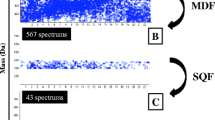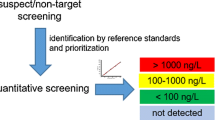Abstract
Purpose
Instrumental capabilities and software tools of modern hybrid mass spectrometry (MS) instruments such as high-resolution mass spectrometry (HRMS), quadrupole time-of-flight (QTOF), and quadrupole linear ion trap (QLIT) were experimentally investigated for the study of emerging contaminants in Henares River water samples.
Methods
Automated screening and confirmatory capabilities of QTOF working in full-scan MS and tandem MS (MS/MS) were explored when dealing with real samples. Investigations on the effect of sensitivity and resolution power influence on mass accuracy were studied for the correct assignment of the amoxicillin transformation product 5(R) amoxicillin-diketopiperazine-2′,5′ as an example of a nontarget compound. On the other hand, a comparison of quantitative and qualitative strategies based on direct injection analysis and off-line solid-phase extraction sample treatment were assayed using two different QLIT instruments for a selected group of emerging contaminants when operating in selected reaction monitoring (SRM) and information-dependent acquisition (IDA) modes.
Results and discussion
Software-aided screening usually needs a further confirmatory step. Resolving power and MS/MS feature of QTOF showed to confirm/reject most findings in river water, although sensitivity-related limitations are usually found. Superior sensitivity of modern QLIT-MS/MS offered the possibility of direct injection analysis for proper quantitative study of a variety of contaminants, while it simultaneously reduced the matrix effect and increased the reliability of the results. Confirmation of ethylamphetamine, which lacks on a second SRM transition, was accomplished by using the IDA feature.
Conclusion
Hybrid MS instruments equipped with high resolution and high sensitivity contributes to enlarge the scope of targeted analytes in river waters. However, in the tested instruments, there is a margin of improvement principally in required sensitivity and data treatment software tools devoted to reliable confirmation and improved automated data processing.





Similar content being viewed by others
References
Berset J-D, Brenneisen R, Mathieu C (2010) Analysis of licit and illicit drugs in waste, surface and lake water samples using large volume direct injection high performance liquid chromatography–electrospray tandem mass spectrometry (HPLC-MS/MS). Chemosphere 81:859–866
Calbiani F, Careri M, Elviri L, Mangia A, Zagnoni I (2006) Matrix effects on accurate mass measurements of low-molecular weight compounds using liquid chromatography-electrospray-quadrupole time-of-flight mass spectrometry. Journal of Mass Spectrometry 41:289–294
Chiaia AC, Banta-Green C, Field J (2008) Eliminating solid phase extraction with large-volume injection LC/MS/MS analysis of illicit and legal drugs and human urine indicators in US wastewaters. Environ Sci Technol 42:8841–8848
Commission Decision 2000/60/EC23. Establishing a framework for community action in the field of water policy. Official Journal of the European Union, pp 1–72
Commission Decision 2002/657/EC. Implementing Council Directive 96/23/EC concerning the performance of analytical methods and the interpretation of results. Official Journal of the European Union L221, 8–36
Farré M, Pérez S, Gonçalves C, Alpendurada MF, Barceló D (2010) Green analytical chemistry in the determination of organic pollutants in the aquatic environment. TrAC—Trends in Analytical Chemistry 29:1347–1362
Fernández-Alba AR, García-Reyes JF (2008) Large-scale multi-residue methods for pesticides and their degradation products in food by advanced LC-MS. TrAC-Trends in Analytical Chemistry 27:973–990
García-Reyes JF, Hernando MD, Molina-Díaz A, Fernández-Alba AR (2007a) Comprehensive screening of target, non-target and unknown pesticides in food by LC-TOF-MS. TrAC—Trends in Analytical Chemistry 26:828–841
García-Reyes JF, Molina-Díaz A, Fernández-Alba AR (2007b) Identification of pesticide transformation products in food by liquid chromatography/time-of-flight mass spectrometry via “fragmentation–degradation” relationships. Anal Chem 79:307–321
Gómez MJ, Gómez-Ramos MM, Malato O, Mezcua M, Férnandez-Alba AR (2010) Rapid automated screening, identification and quantification of organic micro-contaminants and their main transformation products in wastewater and river waters using liquid chromatography–quadrupole-time-of-flight mass spectrometry with an accurate-mass database. Journal of Chromatography A 1217:7038–7054
Huerta-Fontela M, Galceran MT, Martin-Alonso J, Ventura F (2008) Occurrence of psychoactive stimulatory drugs in wastewaters in north-eastern Spain. Sci Total Environ 397:31–40
Kaufmann A (2006) Strategies to avoid false negative findings in residue analysis using liquid chromatography coupled to time-of-flight mass spectrometry. Rapid Communications in Mass Spectrometry 20:3566–3572
Kaufmann A, Butcher P, Maden K, Walker S, Widmer M (2010) Comprehensive comparison of liquid chromatography selectivity as provided by two types of liquid chromatography detectors (high resolution mass spectrometry and tandem mass spectrometry): “Where is the crossover point?”. Analytica Chimica Acta 673:60–72
Kaufmann A, Butcher P, Maden K, Walker S, Widmer M (2011) Semi-targeted residue screening in complex matrices with liquid chromatography coupled to high resolution mass spectrometry: current possibilities and limitations. Analyst 25:979–992
Kellman M, Muenster H, Zomer P, Mol H (2009) Full scan MS in comprehensive qualitative and quantitative residue analysis in food and feed matrices: how much resolving power is required? Journal of the American Society for Mass Spectrometry 20:1464–1476
Kern S, Fenner K, Singer HP, Schwarzenbach RP, Hollender J (2009) Identification of transformation products of organic contaminants in natural waters by computer-aided prediction and high-resolution mass spectrometry. Environ Sci Technol 43:7039–7046
Kosjek T, Heath E, Petrović M, Barceló D (2007) Mass spectrometry for identifying pharmaceutical biotransformation products in the environment. TrAC—Trends in Analytical Chemistry 26:1076–1085
Krauss M, Singer H, Hollender J (2010) LC-high resolution MS in environmental analysis: from target screening to the identification of unknowns. Anal Bioanal Chem 397:943–951
Lacorte S, Fernández-Alba AR (2006) Time of flight mass spectrometry applied to the liquid chromatographic analysis of pesticides in water and food. Mass Spectrometry Reviews 25:866–880
López-Roldán R, de Alda ML, Gros M, Petrovic M, Martín-Alonso J, Barceló D (2010) Advanced monitoring of pharmaceuticals and estrogens in the Llobregat River basin (Spain) by liquid chromatography-triple quadrupole-tandem mass spectrometry in combination with ultra performance liquid chromatography-time of flight-mass spectrometry. Chemosphere 80:1337–1344
Martínez Bueno MJ, Agüera A, Gómez MJ, Hernando MD, García-Reyes JF, Fernández-Alba AR (2007) Application of liquid chromatography/quadrupole-linear ion trap mass spectrometry and time-of-flight mass spectrometry to the determination of pharmaceuticals and related contaminants in wastewater. Anal Chem 79:9372–9384
Martínez Bueno MJ, Agüera A, Hernando MD, Gómez MJ, Fernández-Alba AR (2009) Evaluation of various liquid chromatography–quadrupole-linear ion trap–mass spectrometry operation modes applied to the analysis of organic pollutants in wastewaters. Journal of Chromatography A 1216:5995–6002
Martínez Bueno MJ, Hernando MD, Herrera S, Gómez MJ, Fernández-Alba AR, Bustamante I, García-Calvo E (2010) Pilot survey of chemical contaminants from industrial and human activities in river waters of Spain. Int J Environ Anal Chem 90:321–343
Martínez Bueno MJ, Uclés S, Hernando MD, Dávoli E, Fernández-Alba AR (2011a) Evaluation of selected ubiquitous contaminants in the aquatic environment and their transformation products. A pilot study of their removal from a sewage treatment plant. Water Research 45:2331–2341
Martínez Bueno MJ, Uclés S, Hernando MD, Fernández-Alba AR (2011b) Development of a solvent-free method for the simultaneous identification/quantification of drugs and their metabolites in environmental water by LC-MS/MS. Talanta 85:157–166
Mezcua M, Malato O, García-Reyes JF, Molina-Díaz A, Fernández-Alba AR (2009) Accurate-mass databases for comprehensive screening of pesticide residues in food by fast liquid chromatography time-of-flight mass spectrometry. Anal Chem 81:913–929
Pérez S, Barceló D (2007) Application of advanced MS techniques to analysis and identification of human and microbial metabolites of pharmaceuticals in the aquatic environment. TrAC—Trends in Analytical Chemistry 26:494–514
Pérez-Parada A, Agüera A, Gomez-Ramos MM, García-Reyes JF, Heinzen H, Fernández-Alba AR (2011) Behavior of amoxicillin in wastewater and river water: identification of its main transformation products by liquid chromatography–electrospray quadrupole time of flight mass spectrometry. Rapid Communications in Mass Spectrometry 25:731–742
Petrovic M, Farré M, de Alda ML, Perez S, Postigo C, Köck M, Radjenovic J, Gros M, Barceló D (2010) Recent trends in the liquid chromatography–mass spectrometry analysis of organic contaminants in environmental samples. Journal of Chromatography A 1217:4004–4017
Radjenović J, Petrović M, Barceló D (2007) Advanced mass spectrometric methods applied to the study of fate and removal of pharmaceuticals in wastewater treatment. TrAC—Trends in Analytical Chemistry 26:1132–1144
Sancho JV, Pozo ÓJ, Ibáñez M, Hernández F (2006) Potential of liquid chromatography/time-of-flight mass spectrometry for the determination of pesticides and transformation products in water. Anal Bioanal Chem 386:987–997
Acknowledgements
The authors wish to acknowledge funding from the Spanish Ministry of Education and Science (Programme CONSOLIDER-TRAGUA 2010, CE-CSD2006-00044). A.P.P. also acknowledges the Facultad de Química (UdelaR, Uruguay), Programa de Desarrollo de Ciencias Básicas (PEDECIBA Química, Montevideo, Uruguay), and Agencia Nacional de Investigación e Innovación (ANII, Uruguay, POSNAC-2010-2637) for the economic assistance.
Author information
Authors and Affiliations
Corresponding author
Additional information
Responsible editor: Philippe Garrigues
Electronic supplementary material
Below is the link to the electronic supplementary material.
Fig. S1
Confirmation of metoprolol false positive. a Automatically identified metoprolol fragment 1 (ion formula C15H14NO2; m/z 250.1802). MS spectra, fragmentor voltage 190 V. b MS/MS confirmatory step of the false positive. c Metoprolol ([M+H]+ ion formula C15H26NO3; theoretical m/z 268.1907) MS/MS spectra. For b and c, fragmentor voltage 90 V and CE 20 eV. (GIF 36 kb)
Fig. S2
Effect of the software input—retention time tolerance—on the presentation of database hits in a river water sample. (GIF 48 kb)
Fig. S3
Total ion chromatogram (TIC) obtained by two different QLIT-MS instruments of a river water sample using strategy A: SPE, 400-fold enrichment or B: direct injection analysis. (GIF 35 kb)
Fig. S4
Comparison of direct injection (black line) and SPE (blue line) for the analysis of trigonelline and nicotinic acid by LC-QLIT-MS/MS. (GIF 47 kb)
Rights and permissions
About this article
Cite this article
Pérez-Parada, A., Gómez-Ramos, M., Martínez Bueno, M.J. et al. Analytical improvements of hybrid LC-MS/MS techniques for the efficient evaluation of emerging contaminants in river waters: a case study of the Henares River (Madrid, Spain). Environ Sci Pollut Res 19, 467–481 (2012). https://doi.org/10.1007/s11356-011-0585-2
Received:
Accepted:
Published:
Issue Date:
DOI: https://doi.org/10.1007/s11356-011-0585-2




